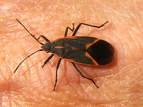Boxelder Bugs
Boxelder bugs are about 3/4 of an inch long, back in color with red lines on their body and wing margins. During summer, they feed on the leaves, flowers and speedpods of boxelders and sometimes silver maples, causing only minor damage to the trees.
summer, they feed on the leaves, flowers and speedpods of boxelders and sometimes silver maples, causing only minor damage to the trees.
Many years, we see boxelder bugs in a wide variety of locations, flower beds, lawns, and walking across driveways and roads. Bumper crops of boxelder bugs are common in dry years because wet weather conditions promotes a fungal disease that attacks these insects and keeps their populations lower.
Adult boxelder bugs lay their eggs on trees in spring. The eggs hatch in 11 to 14 days into nymphs that resemble the adults, but are smaller and have more red on their bodies. The nymphs develop into adults, lay eggs, and a second generation of adults is active in late summer and fall. Warm weather speeds the development of most things in nature, including insects.
Because box elder bugs are not harmful, how you deal with them is a personal choice. Removing all female boxelder trees in an area will prevent breeding, but that isn’t always practical. You can distinguish between female and male boxelder trees because only the female trees produce seeds. The seeds are hanging in clumps and will often remain there throughout the winter. Caulking windows and doors and otherwise eliminating access points will reduce the number of boxelder bugs, ladybugs and other insects from getting into the house.
Once the insects are inside, using a vacuum cleaner is effective. Boxelder bugs are also susceptible to soapy water. Mixing a 4% solution of liquid soap and water and spraying it on the insects will usually kill them.
Another option is to hire a professional to apply insecticides to the sides of your home. if you choose to spray yourself, be sure to test your product ahead of time to be sure you don’t stain your siding. Insecticial soaps, or products containing permethrin, cyfluthrin or estenvalerate are all effective on boxelder bugs.




